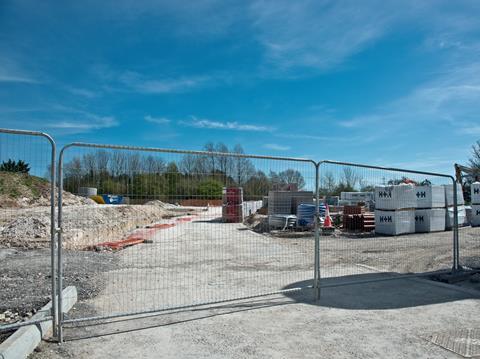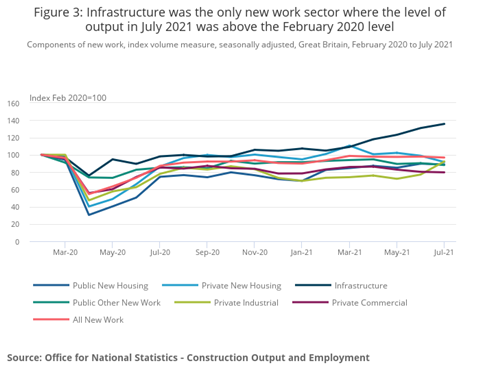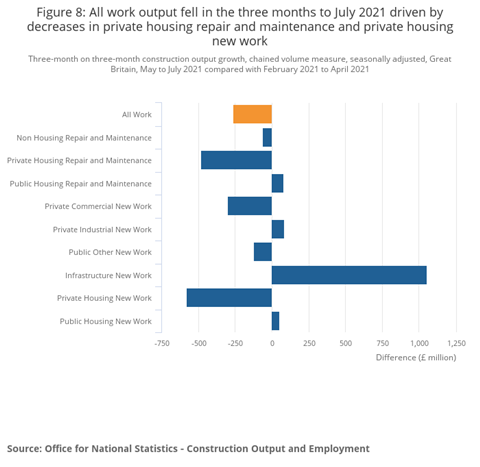Official figures blame 6.5% housebuilding decline on materials shortages and cost increases
The housebuilding industry led a decline in construction work in July, leaving industry output firmly below the level seen prior to the pandemic.
Official figures showed that the seasonally adjusted level of new build housing work dropped by 6.5% in July compared to June, with the drop sharpest in the private housebuilding sector.
The Office for National Statistics said private housing work fell 7.4% to £2.7bn, with public housing output relatively stable, losing just 1% month-on month.

While both numbers are way above the equivalent figures from July last year, when the industry was just recovering from the spring lockdown, they leave output well below pre-pandemic levels. While public housing work has never yet regained its pre-pandemic level, and remained 11.2% under it in July at £491m, private housebuilding activity did top February 2020 levels between February and April this year, but has now fallen back sharply, and sat 8.4% adrift in July.
Recent market data suggests housing demand has fallen back since the government withdrew part of the stamp duty relief introduced in the wake of the 2020 lockdown, and while prices remain high, this is in large part because of a shortage of homes coming on to the market.
Nevertheless, the ONS put the fall in largely down to the continued disruption and cost rises in the supply, caused by widespread materials shortages. The ONS said the housing decline was “driven by the impact of price increases likely caused by product shortages in the sector”.
The month also saw a decline in housing repair and maintenance work of 4%, with private domestic work falling by 6.2%, and public housing work falling by 2.1%.
The decline in housing output contributed significantly to a 1.6% decline in construction output overall in July.
The ONS said anecdotal evidence from businesses suggested that while construction order books remained full “price increases and product shortages caused by supply chain issues” were the main reasons for the decline.
Construction output in July was 1.8% (£257m) below the February 2020 pre-pandemic level.
New work and repair and maintenance work both contributed to the fall, the former was 3.2% below what it was in Feburary 2020, the latter was down 0.6%.
Mark Robinson, group chief executive at Scape, said: “The construction output’s first significant contraction should come as no surprise given the ongoing impact of material and labour shortages in recent weeks.
“Greater collaboration between clients and contractors will remain central to this. This includes holding large contractors to fair payment practices, which will boost cashflow for SMEs and lessen the burden on smaller suppliers.”
Infrastructure has been the best performing sector over the pandemic at 35.7%, or £649m, above its February 2020 level and private commercial the worst performing sector over the pandemic at 20.3%, or £481m, below.

Monthly construction output fell by 1.6% in volume terms in July because of 1.1% and 2.4% declines in new work and repair and maintenance respectively.
Clive Docwra, managing director of McBains, said the problems did not relate to market confidence but to materials shortages, especially imported timber which has seen price rises of more than 60% over the last year.
He said: “Price rises are already evident in recent tender returns, which in turn could fuel wider inflationary pressures.”
Alongside the monthly fall, construction output fell by 0.6% in volume terms in the three months to July, the first three-monthly fall since February 2021, driven by a fall in repair and maintenance of 2.9%.

The decline in repair and maintenance was mainly because of an 8.3% fall in private housing repair and maintenance.
Docwra said: “Private housing and repair and maintenance have been responsible for leading a rise in output in recent months, but these sectors in particular require a lot of timber, and this is reflected by the £217m decline in private housing new work, and £110m fall in repair and maintenance work.”
New work saw an increase of 0.7% in the three months to July, with the largest contributors to this growth the infrastructure and to a lesser extent private industrial sector, which grew by 17.5% and 8.2% respectively.










No comments yet